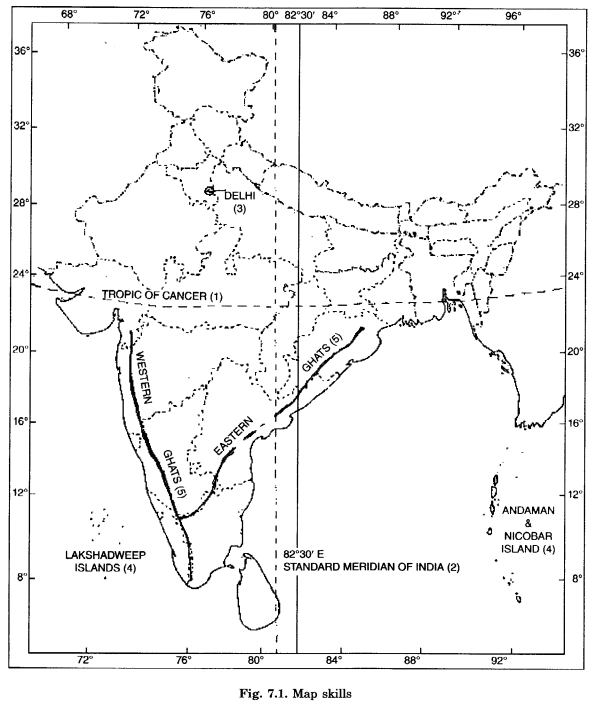NCERT Solutions for Class 6 Social Science Geography Chapter 7 Our Country India are part of NCERT Solutions for Class 6 Social Science. Here we have given NCERT Solutions for Class 6 Social Science Geography Chapter 7 Our Country India.
| Board | CBSE |
| Textbook | NCERT |
| Class | Class 6 |
| Subject | Social Science Geography |
| Chapter | Chapter 7 |
| Chapter Name | Our Country India |
| Number of Questions Solved | 6 |
| Category | NCERT Solutions |
NCERT Solutions for Class 6 Social Science Geography Chapter 7 Our Country India
NCERT TEXTBOOK EXERCISES (Pages 54-55)
Question 1.
Answer the following questions briefly:
(a) Name the major physical divisions of India.
(b) India shares its land boundaries with seven countries. Name them.
(c) Which two major rivers fall into the Arabian Sea?
(d) Name the delta formed by the Ganga and the Brahmaputra.
(e) How many States and Union Territories are there in India? Which states have a common capital?
(f) Why do a large number of people live in the Northern Plains?
(g) Why is Lakshadweep known as a coral island?
Answer:
(a) The major physical divisions of India are :
- Great mountains of the North Himalayas
- North Indian Plain
- Peninsular Plateau
- Coastal Plains
- Islands
(b) Pakistan, Nepal, Bhutan, China, Bangladesh, Sri Lanka, and Afghanistan.
(c) The two major rivers which fall into the Arabian sea are :
- Narmada
- Tapi
(d) The Sundarbans delta.
(e) There are 28 states and 7 Union Territories in India. Punjab and Haryana have a common capital, i.e. Chandigarh.
(f) The Northern plains are generally level and flat and formed by the alluvial deposits Drought down by the rivers Indus, Ganga, and the Brahmaputra and their tributaries. It is fertile land and that is why a large number of people live in the Northern plains.
(g) Lakshadweep is made of corals which are skeletons of tiny marine animals called polyps.
Question 2.
Tick the correct answers.
(a) The Southernmost Himalayas are known as
(i) Shiwaliks
(ii) Himadri
(iii) Himachal
(b) Sahyadris is also known as
(i) Aravali
(ii) the Western Ghats
(iii) Himadri
(c) The Palk Strait lies between the countries
(i) Sri Lanka and the Maldives
(ii) India and Sri Lanka
(iii) India and Maldives
(d) The Indian islands in the Arabian Sea are known as
(i) Andaman and Nicobar Islands
(ii) Lakshadweep Islands
(iii) the Maldives
(e) The oldest mountain range in India is the
(i) Aravali hills
(ii) Western ghats
(iii) Himalayas
Answer:
(a) → (i) Shiwaliks
(b) → (ii) the Western Ghats
(c) → (ii) India and Sri Lanka
(d) → (ii) Lakshadweep Islands
(e) → (i) Aravali hills
Question 3.
Fill in the blanks:
- India has an area of about ………
- The Greater Himalayas are also known as ……….
- The largest state in India in terms of area is ………..
- The river Narmada falls into the ……….. sea.
- The latitude that runs almost halfway through India is ……….
Answer:
- 3.28 million sq. kins.
- Himadri
- Rajasthan
- Arabian
- Tropic of Cancer.
INTEXT QUESTIONS
Question 1.
If we divide the world into Eastern and Western Hemispheres which hemisphere would India belong to?
Answer:
Eastern Hemisphere.
Question 2.
Find out the names of these countries (neighbouring countries) from Figure 7.1 of the Textbook. How many of these countries do not have access to any ocean or sea?

Answer:
Seven neighbouring countries are:
- Afghanistan
- Pakistan
- China
- Nepal
- Bhutan
- Bangladesh
- Myanmar
The following three countries do not have access to the ocean or sea: They are
- Afghanistan
- Nepal
- Bhutan.
Question 3.
Do you know which group of islands were affected by the Tsunami in 2004? Find out through newspaper reports and by speaking to the people how in different ways people faced this challenge when a Tsunami struck the Indian coast.
Answer:
Yes, the Andaman and the Nicobar Islands.
People faced the challenge in the following manner:
- Some people reached high grounds.
- Some climbed up the trees.
- Some remained clung to the tree trunks.
- Some climbed up the upper stair of the house.
- Some swam in the rising waves.
- Hundreds of thousands perished in the waves.
We hope the NCERT Solutions for Class 6 Social Science Geography Chapter 7 Our Country India, help you. If you have any query regarding NCERT Solutions for Class 6 Social Science Geography Chapter 7 Our Country India, drop a comment below and we will get back to you at the earliest.